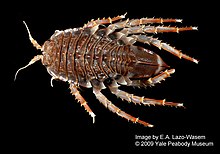Glyptonotus antarcticus
| Glyptonotus antarcticus | |
|---|---|

| |
| Scientific classification | |
| Kingdom: | |
| Phylum: | |
| Class: | |
| Order: | |
| Suborder: | |
| Family: | |
| Genus: | |
| Species: | G. antarcticus
|
| Binomial name | |
| Glyptonotus antarcticus | |
Glyptonotus antarcticus is a benthic marine isopod crustacean in the suborder Valvifera. This relatively large isopod is found in the Southern Ocean around Antarctica. It was first described by James Eights in 1852 and the type locality is the South Shetland Islands.[1]
Description
Glyptonotus antarcticus has a typical maximum length of 9 cm (3.5 in),[2] but may rarely reach up to 20 cm (8 in).[3][4] This is large for an isopod, most of which are between 0.5 and 1.5 cm (0.2–0.6 in) in length.[5] It has two pairs of compound eyes, a large pair on the dorsal surface and a smaller pair on the ventral surface. It is thought that the latter are useful when the animal is swimming, which it does in an upside-down position.[6] With the exception of the eyes, certain mouthparts and feet, the whole surface of the animal has minute cuticular outgrowths of feathery hairs and knobbly scales. It is thought that these may help to prevent attachment of Foraminifera and marine larval organisms on the body surface.[7]
Distribution and habitat
Glyptonotus antarcticus is native to the Southern Ocean around Antarctica, where it occurs in large numbers.[2] It lives on the seabed at depths ranging from the intertidal zone[1] down to more than 600 m (2,000 ft).[2]
Biology
Glyptonotus antarcticus is a carnivore and scavenger and is often caught in baited traps on the seabed. It is an opportunistic predator with a mixed diet which includes a high proportion of echinoderms, but it is also cannibalistic.[8][9] That the available food supply may be fairly constant is shown by the fact that it breeds at any time of year.[8] Females can breed when at least 7.5 cm (3 in) long.[9] The eggs and young are brooded for an extended period—more than 1½ year—in the female's marsupium where they are nourished by a maternal secretion. As typical of Antarctic isopods, there is no pelagic larval stage.[10]
Research
Given its abundance and the fact that it is relatively easy to keep in aquaria, Glyptonotus antarcticus has become an important model organism used as a research object in ecological, biochemical and physiological studies.[2][11][12] A 2005 genetic study suggested that Glyptonotus antarcticus may in fact represent several distinct species.[2]
References
- ^ a b c Gary Poore; Marilyn Schotte (2012). Schotte M, Boyko CB, Bruce NL, Poore GC, Taiti S, Wilson GD (eds.). "Glyptonotus antarcticus". World Marine, Freshwater and Terrestrial Isopod Crustaceans database. World Register of Marine Species. Retrieved 2014-03-30.
{{cite web}}: CS1 maint: multiple names: authors list (link) - ^ a b c d e Held, Christoph; Wagele, Johann-Wolfgang (2005). "Cryptic speciation in the giant Antarctic isopod Glyptonotus antarcticus (Isopoda: Valvifera: Chaetiliidae)" (PDF). Scientia Marina. 69 (suppl. 2): 175–181. doi:10.3989/scimar.2005.69s2175.
- ^ "Seabed (benthic) communities". Australian Government, Department of Agriculture, Water and the Environment: Australian Antarctic Division. 12 August 2010. Retrieved 16 June 2020.
- ^ White, M.G. (1970). "Aspects of the breeding biology of Glyptonotus antarcticus (Eights)(Crustacea,Isopoda) at Signy Island, South Orkney Islands". In M.W. Holdgate (ed.). Antarctic Ecology. Vol. 1. Academic Press, London. pp. 279–285. ISBN 978-0123521026.
- ^ Ruppert, Edward E.; Fox, Richard, S.; Barnes, Robert D. (2004). Invertebrate Zoology, 7th edition. Cengage Learning. p. 662. ISBN 978-81-315-0104-7.
{{cite book}}: CS1 maint: multiple names: authors list (link) - ^ Meyer-Rochow, V. B. (1982). "The divided eye of the isopod Glyptonotus antarcticus: effects of unilateral dark adaptation and temperature elevation". Proceedings of the Royal Society B. 215 (1201): 433–450. doi:10.1098/rspb.1982.0052.
- ^ Meyer-Rochow, V. B. (1980). "Cuticular surface structures in Glyptonotus antarcticus — a marine isopod from the Ross Sea (Antarctica)". Zoomorphologie. 94 (2): 209–216. doi:10.1007/BF01081935.
- ^ a b Clarke, A. (1979). "Assimilation efficiency of the Antarctic marine isopod Glyptonotus antarcticus". Marine Biology. 52 (2): 157–160. doi:10.1007/BF00390423.
- ^ a b Janecki, T.; S. Rakusa-Suszczewski (2006). "Biology and metabolism of Glyptonotus antarcticus (Eights) (Crustacea: Isopoda) from Admiralty Bay, King George Island, Antarctica". Polar Biosc. 19: 29–42.
{{cite journal}}: Cite has empty unknown parameter:|1=(help) - ^ Janssen, H.H.; B. Hoese (1993). "Marsupium morphology and brooding biology of the Antarctic giant isopod, Glyptonotus antarcticus Eights 1853 (Crustacea, Isopoda, Chaetiliidae)". Polar Biology. 13: 145–149.
- ^ Leese, Florian; Mayer, Christoph; Held, Christoph (2008). "Isolation of microsatellites from unknown genomes using known genomes as enrichment templates" (PDF). Limnology and Oceanography: Methods. 6: 412–426. doi:10.4319/lom.2008.6.412. Archived from the original (PDF) on 2016-03-04. Retrieved 2014-04-09.
- ^ Römisch, Karin; Matheson, Tom (2003). "Cell biology in the Antarctic: studying life in the freezer" (PDF). Nature Cell Biology. 5 (1): 3–5. doi:10.1038/ncb0103-3. PMID 12511880.
